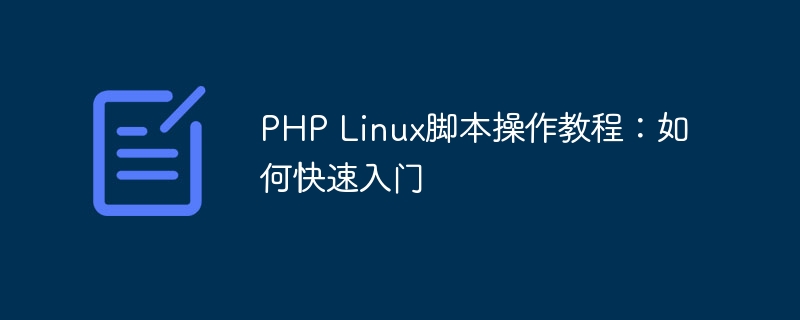

PHP (Hypertext Preprocessor) is a scripting language widely used in web development. It supports multiple operating systems, including Linux. In the Linux environment, PHP scripts have very powerful operating capabilities and can be used in various fields such as file operations, system management, and network communications. This tutorial will introduce how to use PHP scripts in Linux systems and provide specific code examples.
1. Environment preparation
Before you start learning, you need to make sure that your system has a PHP interpreter installed. You can check whether it has been installed by running the following command:
php -v
If the PHP version information is displayed, it means it has been successfully installed. If it is not installed, you can install it through the following command:
sudo apt-get install php
2. File operation
Read file contents
Use the file_get_contents() function to read The contents of the file and stores it as a string variable. The following code example demonstrates how to read a file and output its contents to the browser:
<?php $file = "test.txt"; $content = file_get_contents($file); echo $content; ?>
Writing file contents
Use the file_put_contents() function to write to a file Enter content. The following code example demonstrates how to write a piece of text to a file:
<?php $file = "test.txt"; $content = "Hello, World!"; file_put_contents($file, $content); ?>
Copy, move and delete files
Use the copy() function to copy a file, use rename( ) function can move files, and use the unlink() function to delete files. The following code example demonstrates how to copy, move and delete files:
<?php
$sourceFile = "source.txt";
$destinationFile = "destination.txt";
// 复制文件
if (copy($sourceFile, $destinationFile)) {
echo "文件复制成功!";
} else {
echo "文件复制失败!";
}
// 移动文件
if (rename($sourceFile, "newfile.txt")) {
echo "文件移动成功!";
} else {
echo "文件移动失败!";
}
// 删除文件
if (unlink("file.txt")) {
echo "文件删除成功!";
} else {
echo "文件删除失败!";
}
?>3. System Management
Execute system commands
Use The exec() function can execute system commands. The following code example demonstrates how to execute a system command and output the results to the browser:
<?php
$output = exec("ls -l");
echo $output;
?>Starting and stopping services
Use the system() function to start and stop the Linux system services in. The following code example demonstrates how to start and stop the Apache HTTP server:
<?php
// 启动Apache服务器
system("sudo systemctl start apache2");
// 停止Apache服务器
system("sudo systemctl stop apache2");
?>4. Network Communication
Send HTTP Request
Use The curl library can send HTTP requests in PHP scripts. The following code example demonstrates how to send a GET request and get the response through a PHP script:
<?php $url = "https://api.example.com/data"; $ch = curl_init($url); curl_setopt($ch, CURLOPT_RETURNTRANSFER, true); $response = curl_exec($ch); curl_close($ch); echo $response; ?>
Receive HTTP Request
Use the $_GET and $_POST global variables to do this in a PHP script Receives the parameters of the HTTP request. The following code example demonstrates how to receive the parameters of a GET request and output them to the browser:
<?php $param = $_GET['param']; echo $param; ?>
This tutorial introduces the basics of operating with PHP scripts on a Linux system, and Specific code examples are provided. I hope it can help readers get started quickly and use the powerful functions of PHP scripts in actual development. If you want to learn more in depth, you can consult PHP official documentation or other related resources. Happy studying!
The above is the detailed content of PHP Linux Scripting Tutorial: How to Get Started Quickly. For more information, please follow other related articles on the PHP Chinese website!